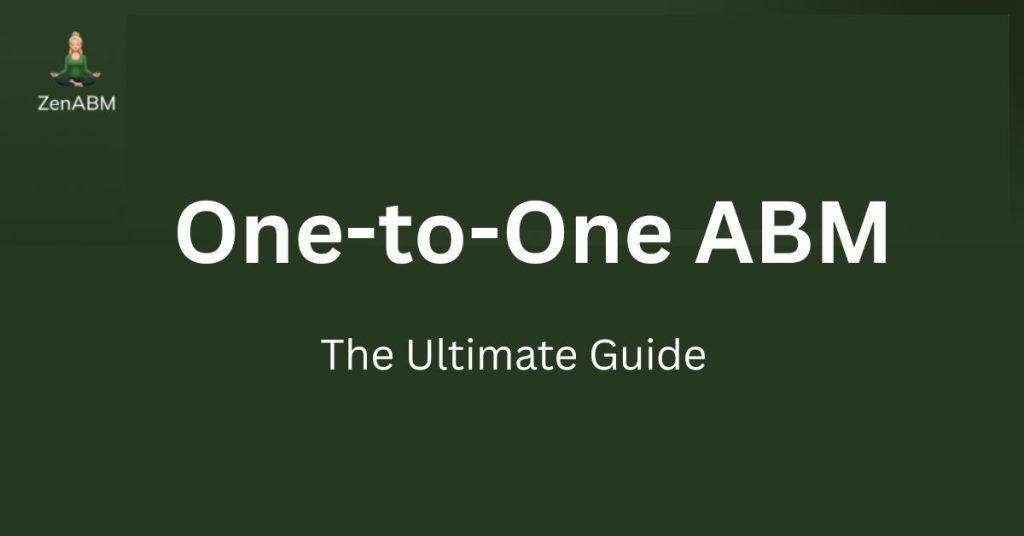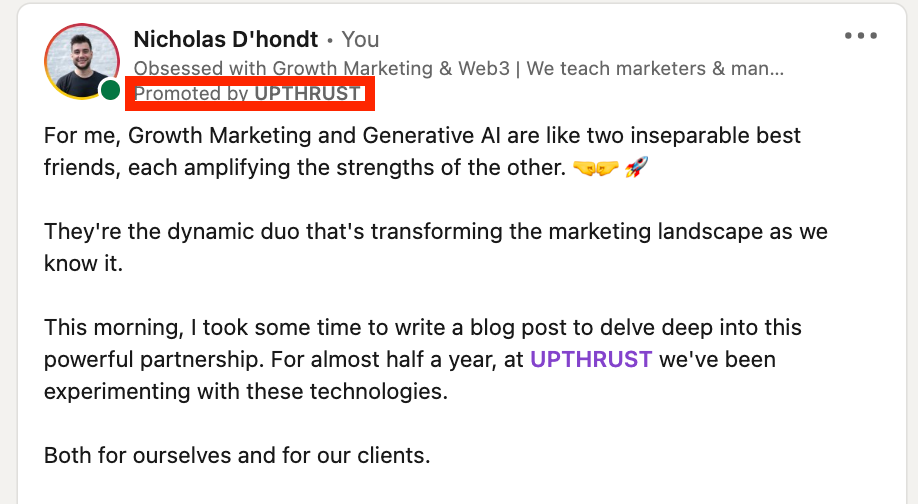In this guide to one-to-one ABM, I have covered the whole motion end-to-end. From selecting and tiering target accounts to orchestrating personalized plays at scale. From RevOps alignment to advanced qualification frameworks like SPICED and MEDDPICC. From measurement to iteration.
I have also discussed how ZenABM can support your ABM strategy at every step.
Read on…
The Ultimate Guide to One-to-One ABM: Short Summary
- One-to-one ABM focuses on your highest-value accounts with bespoke, executive-level programs.
- Classic motions (1:1, 1:few, 1:many) still matter but now operate in a fluid, adaptive model.
- Begin with a tight 1:1 core and expand to 1:few or 1:many once the engine proves itself.
- Build an ICP from hard data plus field intel. Validate it with customer and win/loss insights.
- Prioritize by deal value and strategic impact, not just company size or logo glamour.
- Continuously refine target lists with sales and RevOps. Treat the list as a living asset.
- Deep research (reports, job posts, earnings, news) enables surgical personalization.
- Create account dossiers to capture context and shape messaging and offers.
- Use frameworks like SPICED and MEDDPICC to map stakeholders and steer strategy.
- Coordinate multi-channel outreach (email, LinkedIn, paid, gifting, events) with precise timing.
- Lock tight sales–marketing alignment so every touch tells one story.
- Use a coherent ABM stack: data intelligence, automation, CRM/MAP, personalization, sales engagement, analytics.
- ZenABM is purpose-built for LinkedIn-led ABM. It tracks account engagement, syncs to CRM, alerts sales, and ties programs to pipeline.
- Invest in data hygiene. Bad data kills personalization and wastes budget.
- ABM’s next curve: AI assist, ABX across the lifecycle, tighter product/CS loops, and inventive physical experiences.
One-to-One ABM: The Stakes Are High
One-to-one ABM is the varsity level of B2B go-to-market.
Think multi-million dollar opportunities, double-digit buying teams, and long enterprise cycles. Spray-and-pray demand gen won’t move these deals.
You don’t approach a Fortune 500 the way you’d approach an SMB. One-to-one ABM treats each target as a market of one. You execute coordinated, personalized plays that outmaneuver competitors and win over entire organizations.
Complexity is part of the game.
You’ll navigate:
- Complex buying paths: Many stakeholders. Conflicting priorities. Heavy diligence. Procurement rigor.
- Long timelines: Nurture for quarters, sometimes years. Patience and persistence win.
- Relationship equity: You’re building long-term partners, not one-off transactions.
Before execution, anchor your approach in frameworks and operating principles that scale.
One-to-One, One-to-Few, One-to-Many: ABM at Scale (Why the Old “Triangle” Is Shifting)
Traditionally, ABM runs in three modes:
One-to-One ABM (Strategic ABM)
Hyper-personalized programs for top-tier “whales.” Messaging, content, and outreach tuned to a single account’s context. Reserved for accounts worth seven or eight figures.
One-to-Few ABM (ABM Lite)
Personalized campaigns for clusters of look-alike accounts (e.g., 5–15) within a vertical or segment. Templated at the cluster level, customized where it matters.
One-to-Many ABM (Programmatic ABM)
Broader, tech-powered touches for dozens or hundreds of accounts. Dynamic ads. Automated nurtures. Your scale layer.
This is usually drawn as a pyramid of effort vs. reach:
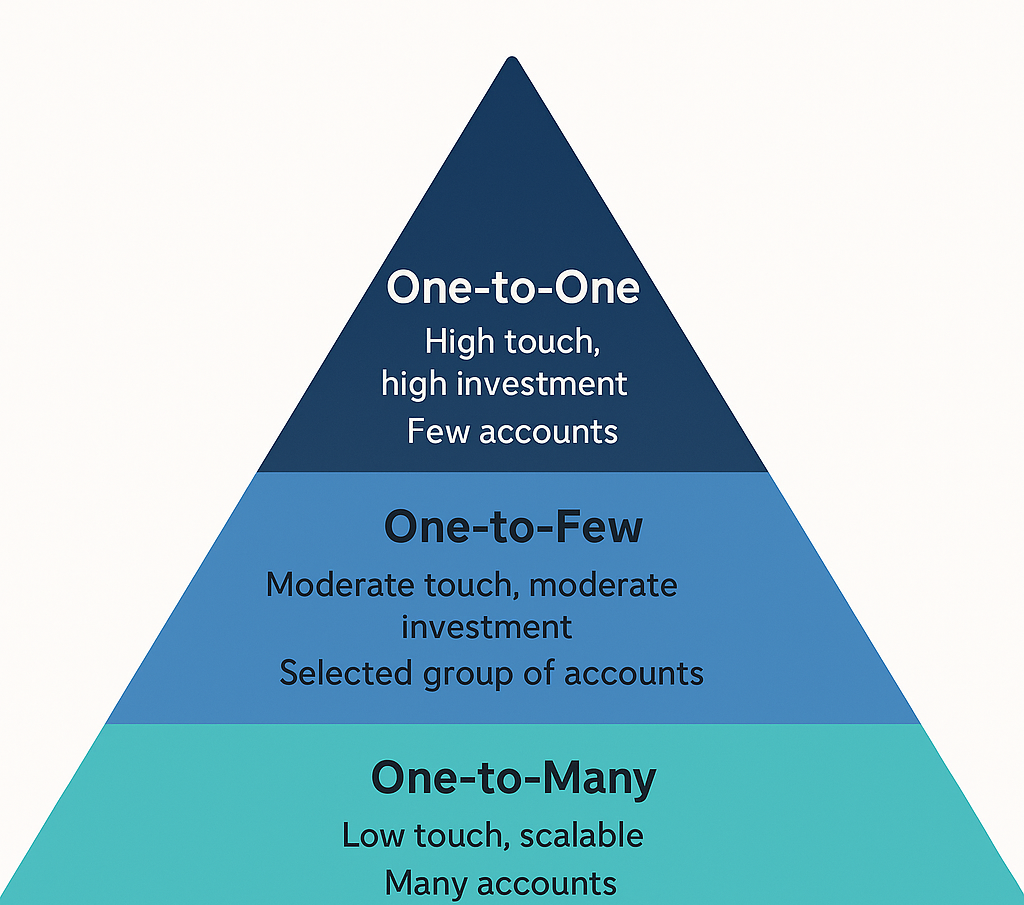
Few accounts receive true white-glove 1:1 at the top; many get lighter programmatic touches at the base.
That model still helps.
The Global Account-Based Marketing Benchmark shows most programs run multiple motions in parallel.
Don’t Treat the Triangle as Law

Avoid rigid silos. Leading practitioners call for agility. As Rhiannon Blackwell notes in a Momentum ITSMA piece, the playbook must be dynamic and client-centric.
In practice, you’ll dial investment up or down in real time. If a mid-tier account signals urgent, strategic pain, escalate it to 1:1 treatment. If a supposed Tier 1 goes cold, scale back until they re-engage.
Bottom line: Keep tiers, stay fluid.
Pro Tip: New to enterprise? Nail true 1:1 for five flagship accounts rather than “ABM” a list of 500 with generic touches. Expand to 1:few and 1: many once the foundation is solid. Some teams even begin with existing customers to land expansion before chasing net-new.
Now let’s execute one-to-one ABM step by step.
Selecting Target Accounts: The Foundation of One-to-One ABM
Your list is your strategy.
That’s true for all ABM, but it’s existential for 1:1.
Here’s how to build a list that deserves a one-to-one motion:
Define Your ICP With Real Rigor
Don’t settle for vague personas. Build a data-backed picture of accounts most likely to become high-value customers.
Blend firmographics, technographics, pains and use cases, and any predictors tied to wins.
If you have enterprise customers already, mine what your best logos share.
Combine Quantitative and Qualitative Signals
Use CRM and third-party data to score accounts against ICP criteria (revenue, headcount, growth).
Layer intent. If Bombora or 6sense shows surging interest in a topic you solve, that’s a heat signal.
Add field intel. Sales and CS know whose priorities align with you. Run weekly RevOps reviews to weigh data plus judgment.
Pro Tip: You can “bake in” intent via ad structure. If you sell product tooling, split campaigns by features like analytics or session replay.
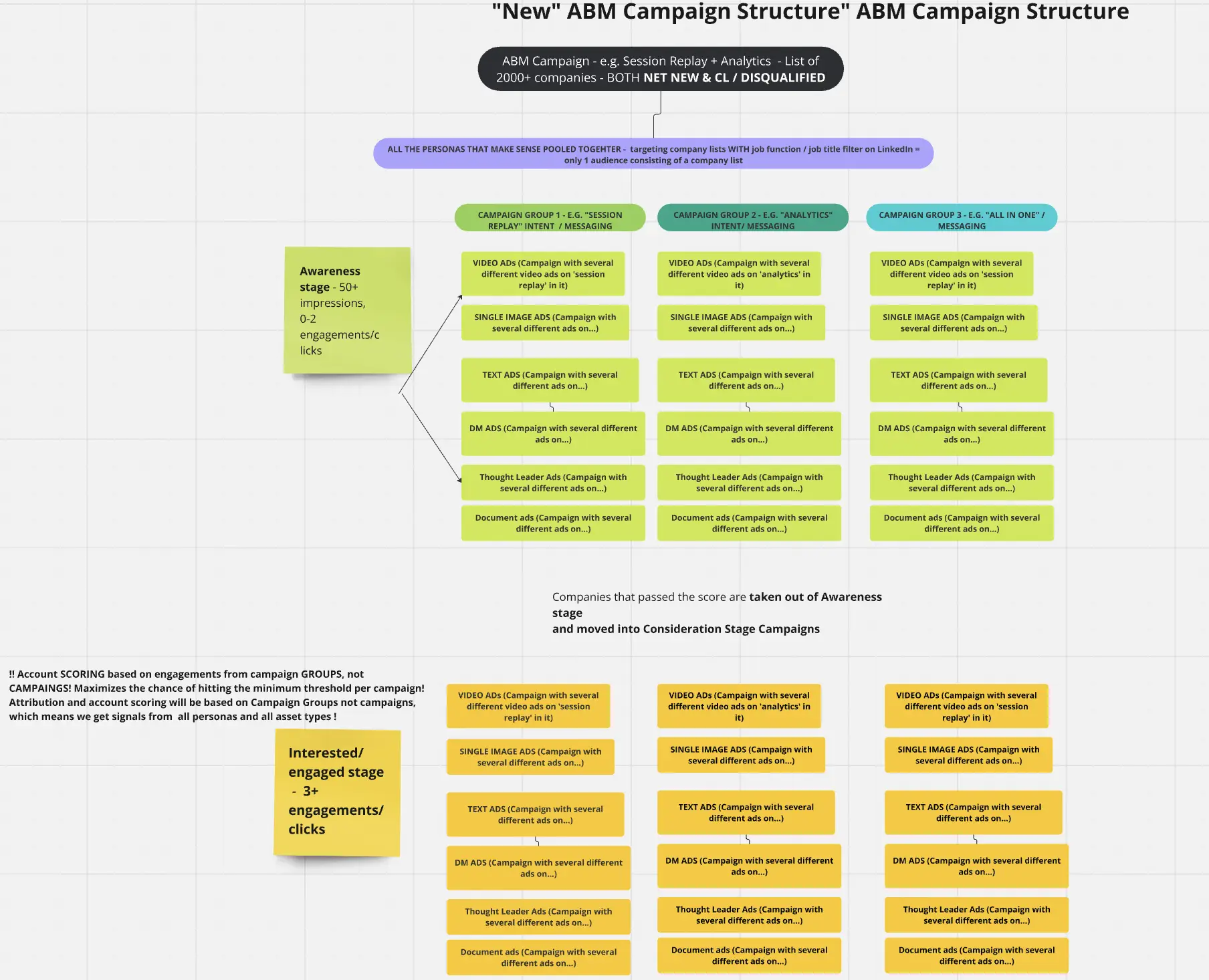
Then, in ZenABM, tag each ad with intent. Once live, ZenABM groups companies by similar intent:
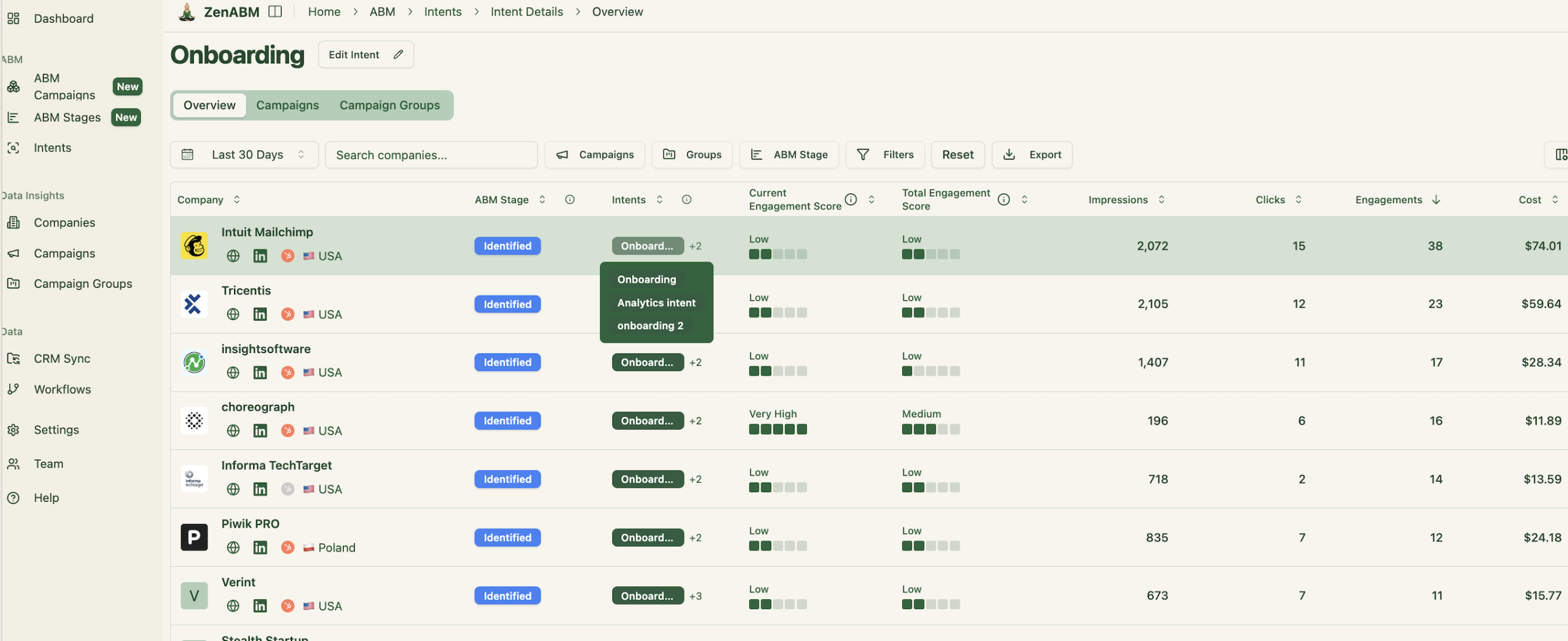
It also pushes intent into your CRM as a company property so sales can act fast:
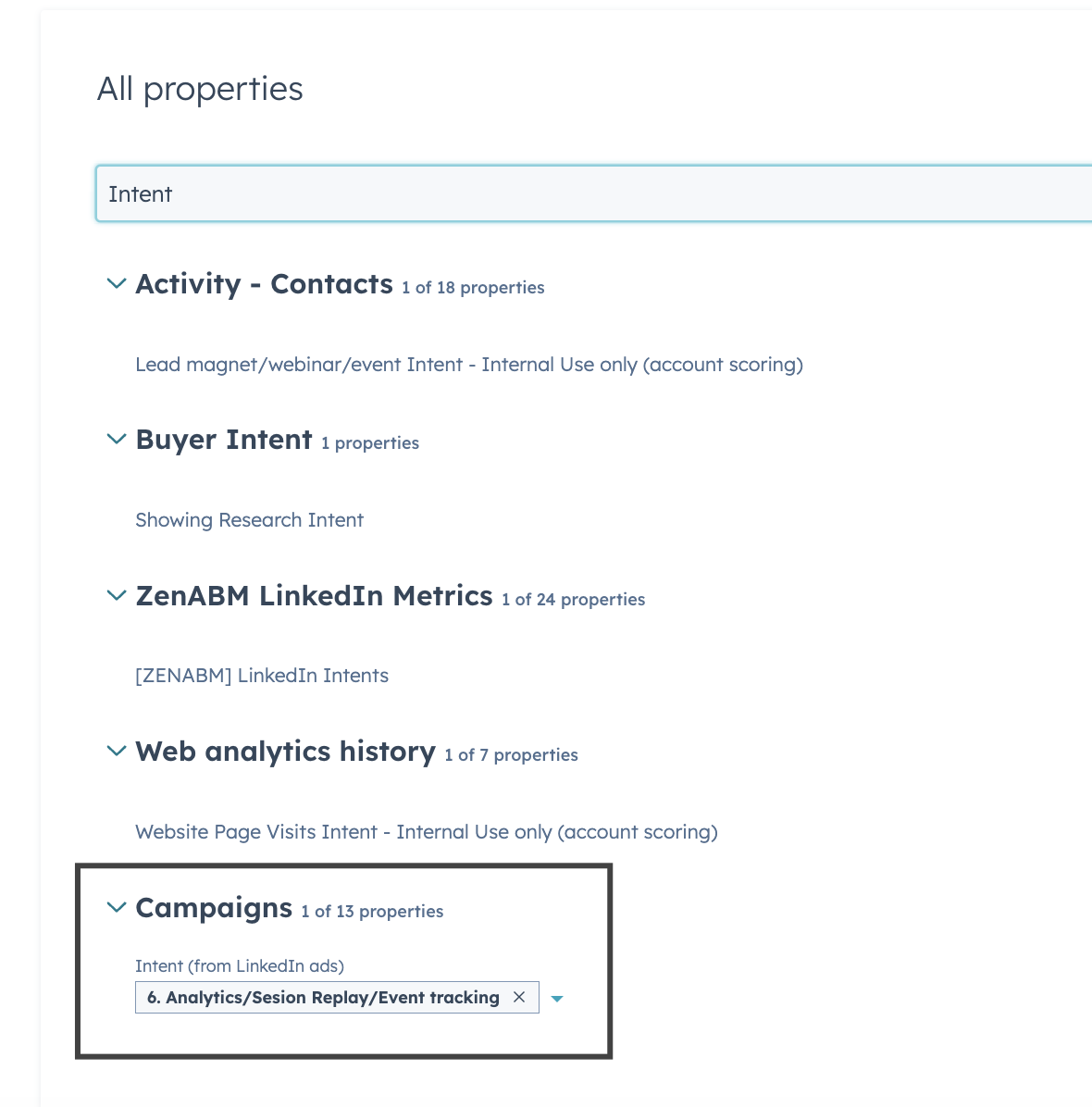
Tier and Prioritize (Value Over Labels)
Your candidate list will exceed your capacity.
Create tiers. Example: Tier 1 = 10–20 accounts (1:1), Tier 2 = next 50 (1:few by vertical/region), Tier 3 = next 200 (programmatic nurture).
Prioritize by potential value and likelihood to win.
A Reddit practitioner put it well: focus segmentation on deal size, not “account type.”

If a small company represents a big deal, give it enterprise-grade, one-to-one ABM.
Validate and Refine in Motion
Selection isn’t one-and-done.
Markets shift. Orgs reorganize.
Review quarterly or twice a year. Add emergent winners. Park the zombies.
High performers start narrow and scale. Many pilot with ~20 accounts, then expand once the model works.
Secure early buy-in on the target list from sales leadership. ABM dies when there’s no agreement on must-win accounts. Choose targets together and get sign-off from the CRO or VP Sales. When sales co-owns the list, they work it.
Alignment is the essence of ABM, per experts like Dave Rigotti.
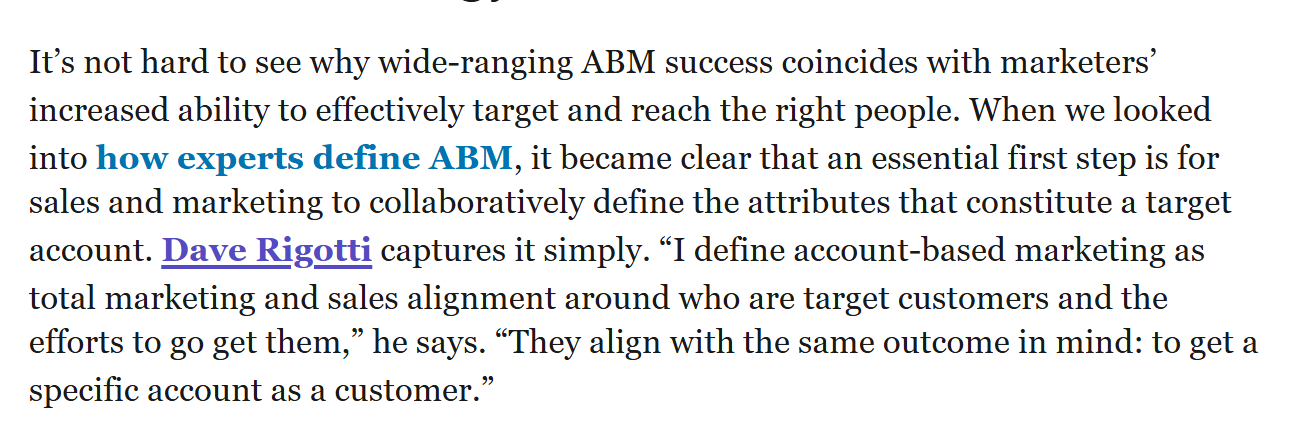
Real-world: In CrossKnowledge’s ABM pilot, the team agreed early to an account-centric approach and a shared list. That alignment helped the program source 60% of the enterprise pipeline.
Deep Research & Personalization
At the enterprise level, “Hi <Name>” is table stakes.
You need account-level insight, pinpoint messaging, and bespoke content that fits their world.
ABM often feels like detective work plus strategy.
A marketer on Reddit called it “Sherlock Holmes with a scalable plan.”
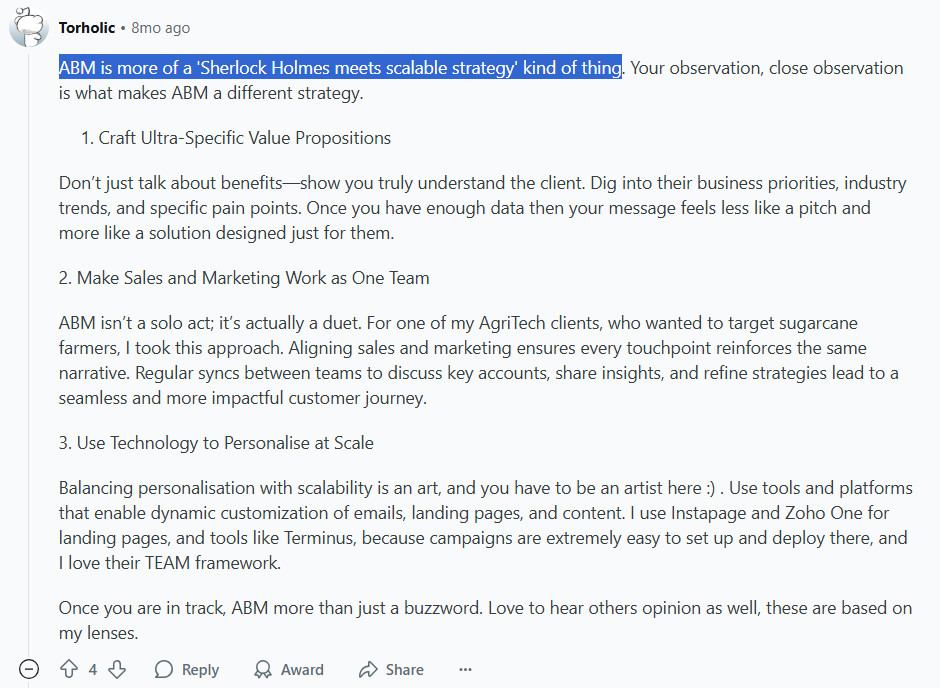
Investigate deeply:
- annual reports,
- press and newsroom pages,
- earnings transcripts,
- LinkedIn and executive posts,
- industry coverage,
- job postings,
- and intel from sales or your network.
Know their priorities and constraints almost as well as they do.
Then craft value propositions that are unmistakably for them.
Here are practical ways to scale personalization in a one-to-one ABM program:
Enterprise Account Dossiers
Create a one-pager or wiki per target capturing:
- company overview,
- strategic initiatives,
- recent developments,
- pain themes and current vendors,
- key stakeholders and profiles.
For hot accounts, make it richer and keep it fresh.
Template:
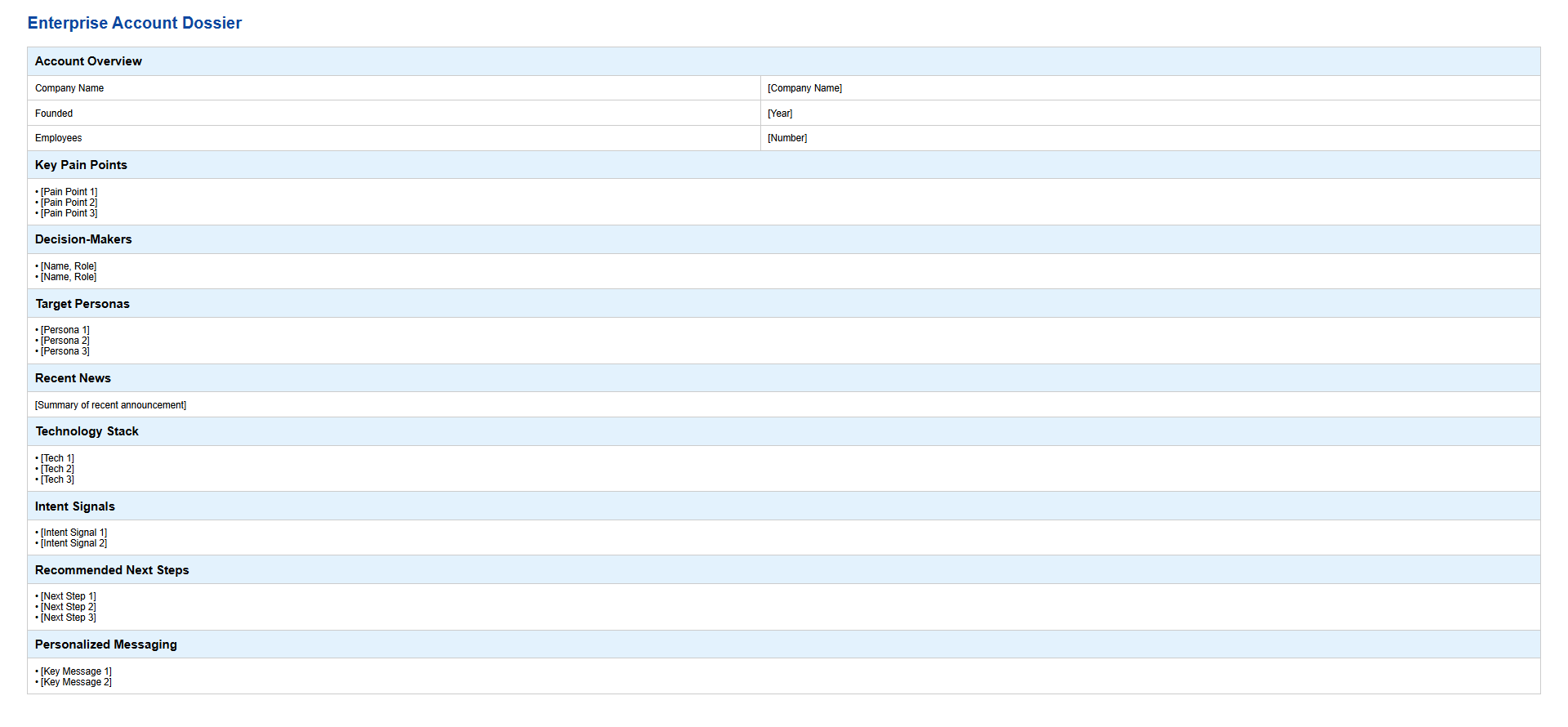
Pro Tip: Add look-alike proof. Show how you solved a similar company’s pains and how you’ll tailor that playbook here.
Personalized Content, Offers, and Value Props
Deliver content and offers designed for that account.
- Use look-alike case studies. If you won with a CRM platform, show that to another CRM platform. Example: DocuSign’s Salesforce case study.
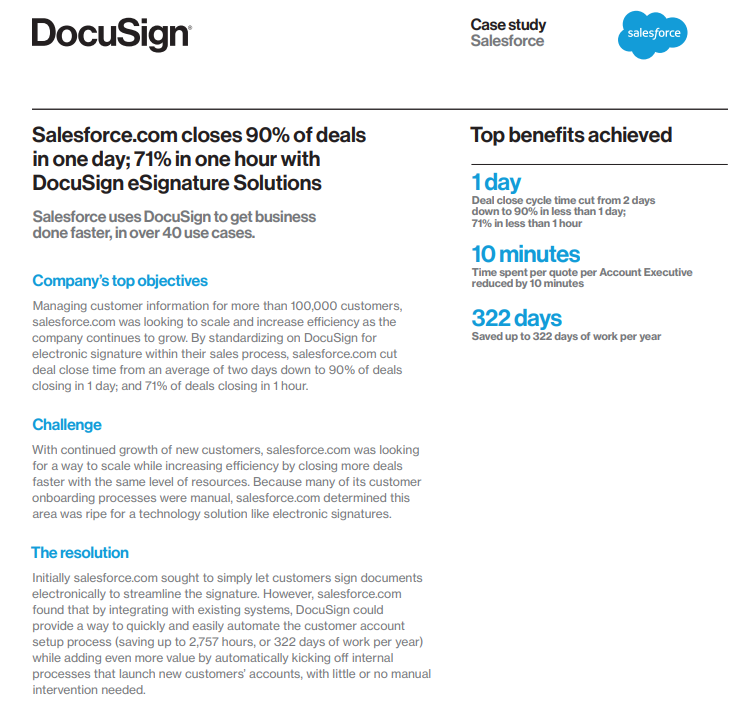
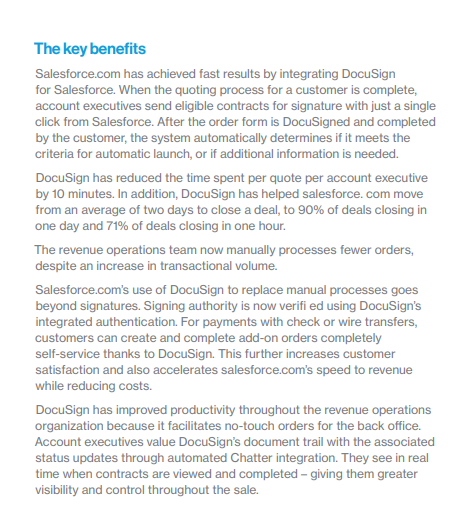
- Use their vocabulary and scenario, but anchor it in real proof and clear value. Non-negotiable.
- Some teams create private microsites or “resource hubs” per flagship account. Demandbase supports this at the enterprise end:
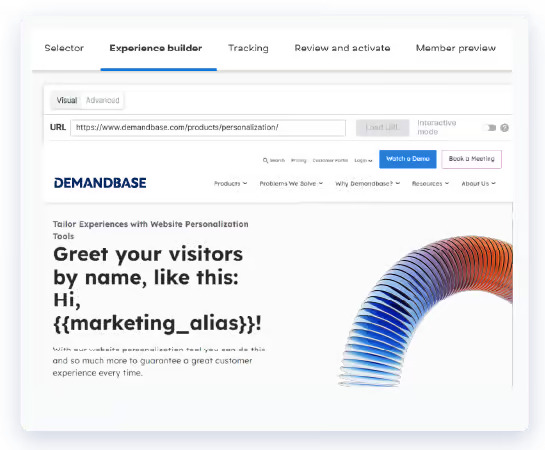 If you want targeted hubs without a full-stack platform, here are focused tools for microsites and hyper‑personalization:
If you want targeted hubs without a full-stack platform, here are focused tools for microsites and hyper‑personalization:
Tool Name Unique Features Pricing (Approx) Mutiny AI website personalization and ABM microsites; Salesforce and Marketo integrations Starts at $3,000/month PathFactory Dynamic content tracks and tailored flows with deep analytics Custom pricing Folloze No-code personalized microsites; AI-assisted content curation and targeting Starts at $2,500/month Uberflip Drag-and-drop hubs and personalized pages for ABM Starts at $2,000/month Ion Interactive Interactive experiences like quizzes and ROI tools with CRM/MAP integrations Custom pricing Turtl Personalized content hubs with engagement analytics Starts at $1,200/month Knak Modular email and landing page builder with governance controls Starts at $1,500/month Paperflite Per‑account content experiences with engagement heatmaps Starts at $1,200/month EngageSoft Account-level personalization for microsites and ABM pages Custom pricing Ceros Highly interactive content with motion, animation, and tracking Starts at $3,000/month - Consider one-to-one videos from your execs to theirs, small private webinars, and workshops tailored just for that team.
Map the Whole Buying Committee
Enterprise deals involve many roles: users, technical evaluators, finance, legal, and the executive buyer.
Don’t wait until the late stages to map them. Modern DMUs can be large. Consultants like Debjit Sen (Engrow) stress this point:
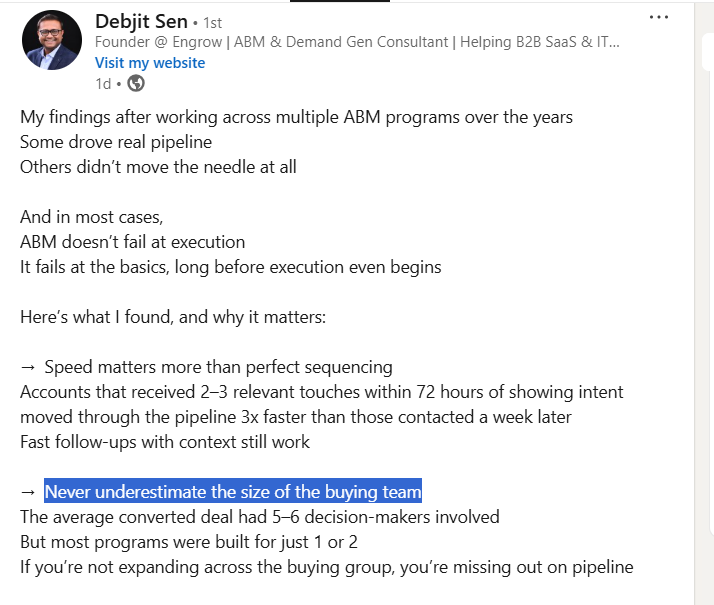
And it’s not rare to see 11+ in a committee per industry studies.
So personalize at the persona level inside the account.
Make it part of your core motion, not a last-minute patch.
Use SPICED to structure this:
- Situation
- Pain
- Impact
- Critical Event
- Decision
It helps you diagnose what each role cares about.
Expert Tip: Wouter Dieleman maps SPICED factors to each persona so every message lands in context:
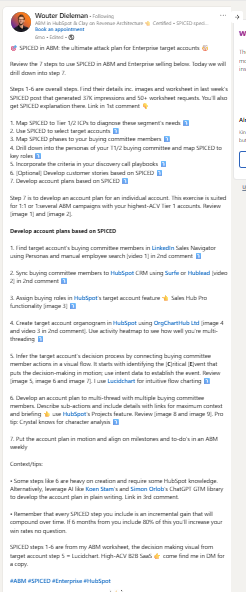
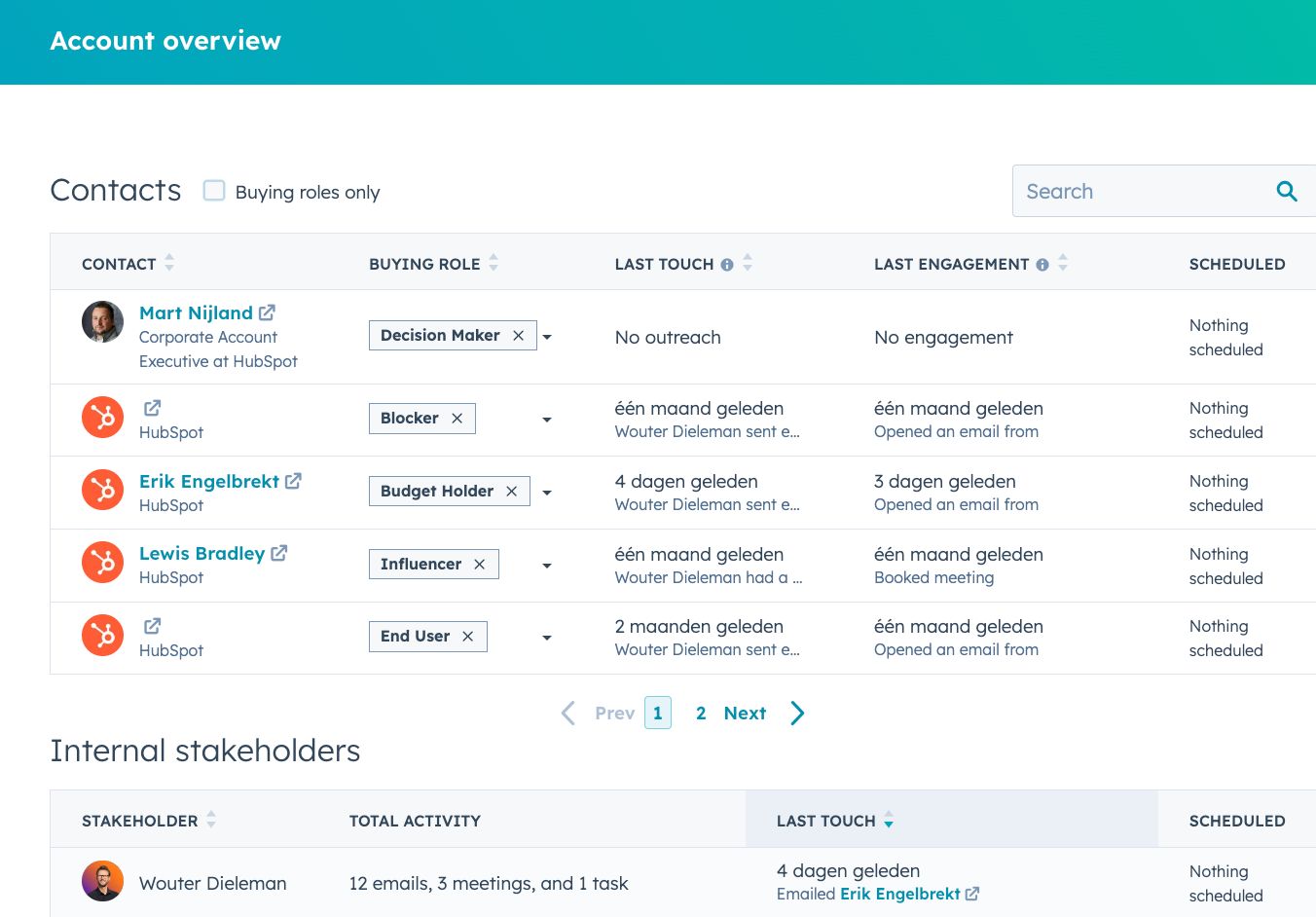
Use Triggers for Timing
Personalization is also timing.
New CTO hired? Congratulate and show how peers onboard tech leadership quickly with your platform.
New product line? Share a specific plan to de-risk launch and accelerate adoption.
Free Resource: The ColdIQ team published a list of 93 sales triggers:
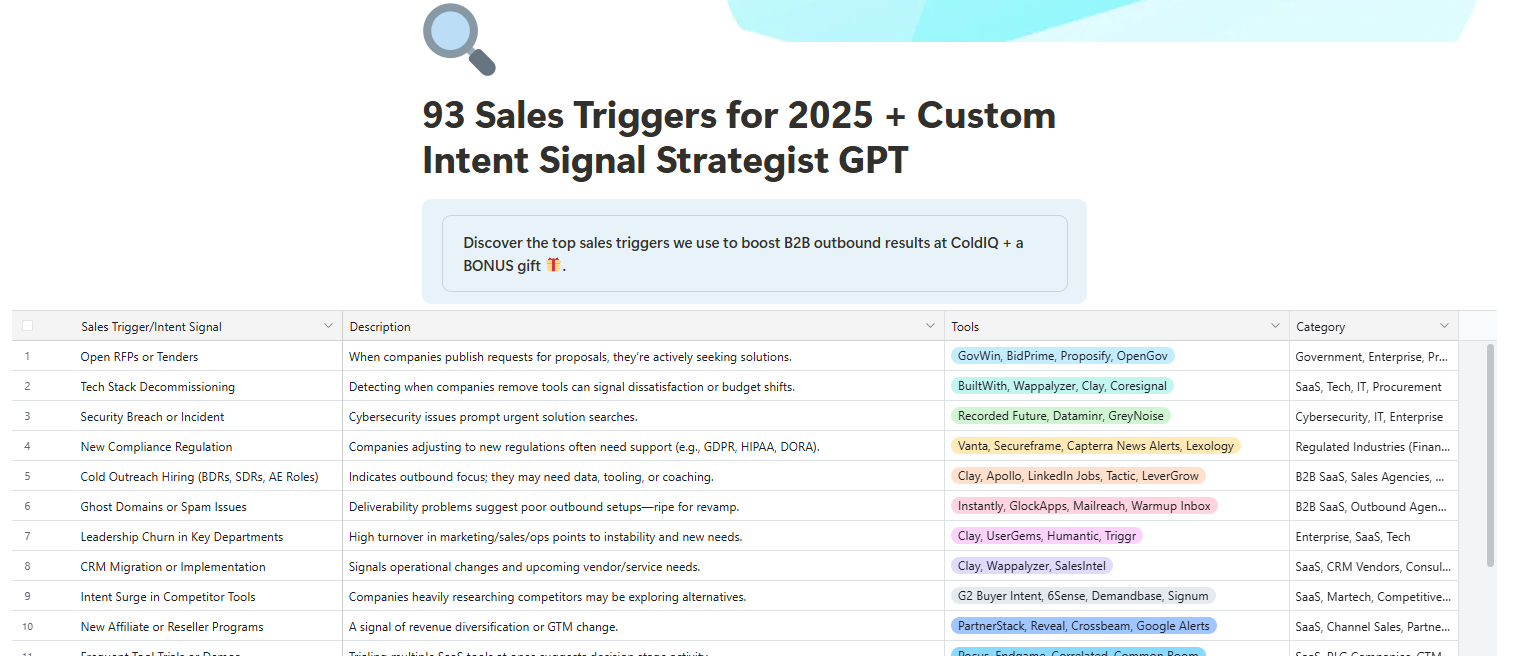
They even built a Custom GPT to help teams select and track the right triggers:
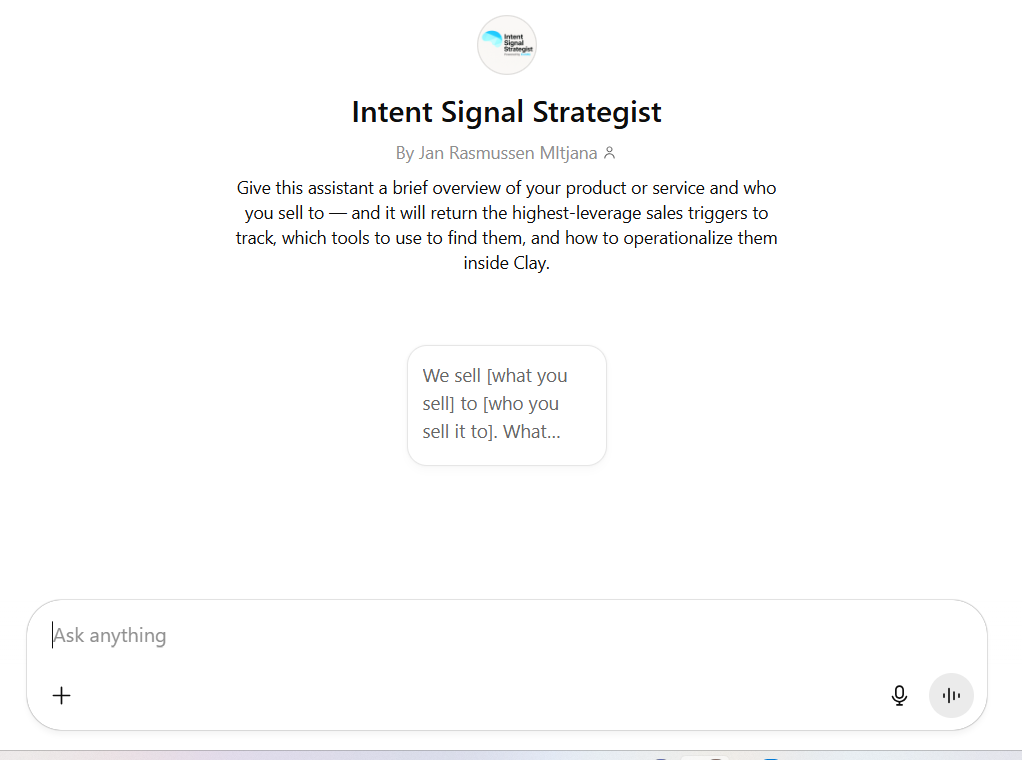
Trust wins enterprise deals. Prove you understand the account and are committed to its outcomes.
Orchestrating Multi-Channel One-to-One ABM (Without Losing the Plot)
One-to-one ABM surrounds the account with coordinated, channel-spanning touches.
You’re influencing a committee over time. No single email or ad will do the job.
Design a campaign arc where each touch reinforces the same narrative from different angles.
Core channels in the ABM playbook:
Email (Surgical and Sender-Right)
Email still works when it’s relevant and human.
- Every message must be timely and specific.
- Match sender to recipient seniority (CEO to CEO, architect to engineering lead).
- Lead with their world, not yours. Aim for 80/20 about them vs. you.
- Coordinate with sales so touches layer, not collide.
LinkedIn and Social
LinkedIn is a one-to-one ABM powerhouse:
- Have reps and SMEs connect and engage with stakeholders.
- Publish thought leadership aimed at target industries and name the problem space.
- Use Thought Leader Ads to sponsor posts from exec profiles to specific committees.
- Use Sales Navigator for insights and deal mapping. Feed reps curated posts to share.
Account-Targeted Ads
Demandbase, 6sense, Terminus, and LinkedIn enable account-specific targeting.
Sequence the creative by stage. Awareness gets the problem education. Consideration gets proof. Decision gets ROI and risk removal.
If you buy LinkedIn, use ZenABM to track account engagement.
It shows impressions, clicks, and engagement per company for each LinkedIn ad:

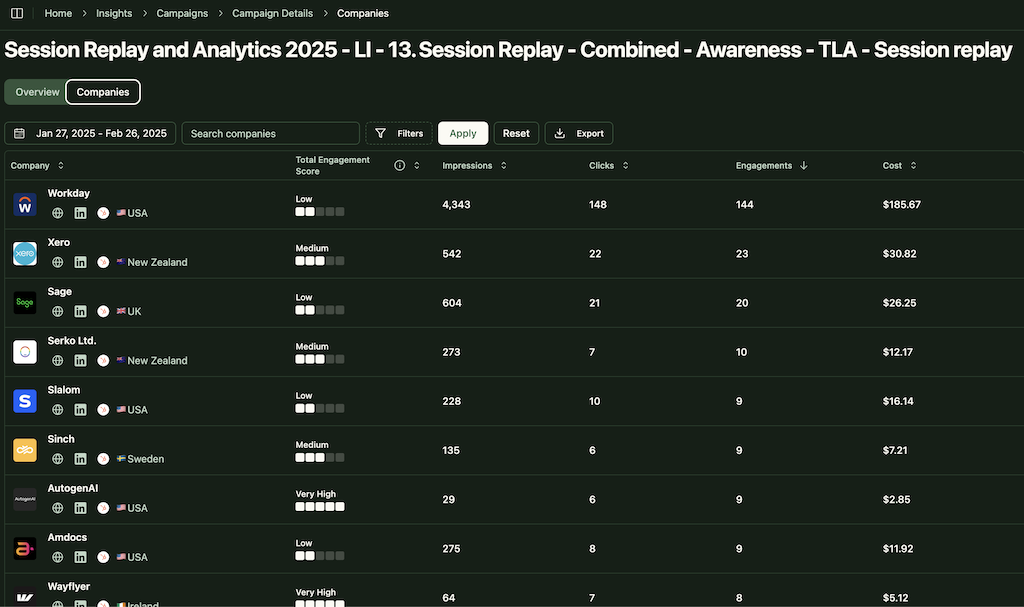
Gifting
Use thoughtful direct mail or e-gifts at key moments.
After a strong multi-stakeholder call, send a relevant thank-you. It builds goodwill and momentum.
Additional Channels
Beyond the big three, mix in:
- Podcasts
- Small, in-person executive sessions
- Flagship events
- Communities like Reddit and Slack
Sales Outreach and Account Development
ABM works when sales and marketing interleave their touches.
Warm with ads and content. Then a rep references that activity in outreach.
Build an account playbook with weekly steps and owners:
- Week 1 – Exec connects on LinkedIn
- Week 2 – Personalized case study via email
- Week 3 – SDR call with a workshop invite
- Week 4 – Direct mail follow-up, then adapt based on signals
Caution: Keep one narrative. Don’t let channels or teams contradict each other. As one Reddit expert put it, alignment ensures every touch compounds impact.
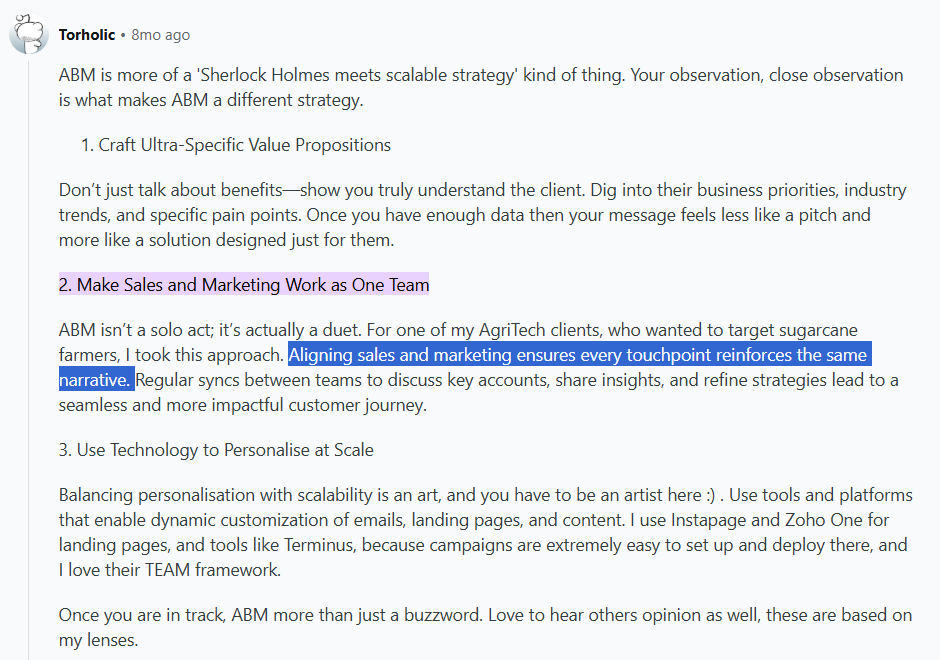
Advanced One-to-One ABM Frameworks and Methods
Here are advanced patterns elite teams use:
The TEAM Framework (Target, Engage, Activate, Measure)
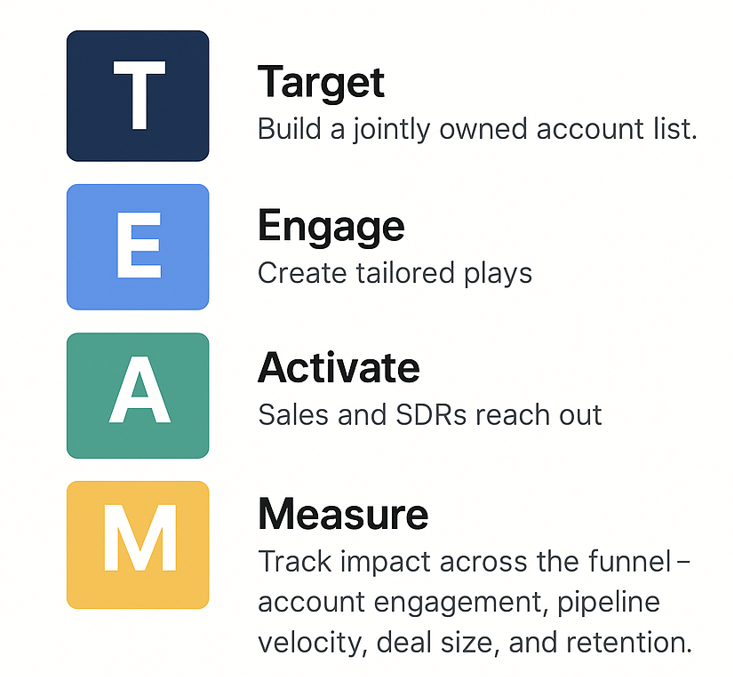
Popularized by Terminus, TEAM gives a plain-English operating loop:
- Target: Pick and prioritize accounts.
- Engage: Reach them across channels with relevant content.
- Activate: Turn marketing heat into sales action.
- Measure: Track account-level revenue, pipeline, engagement. Optimize.
It’s easy for cross-functional teams to align on.
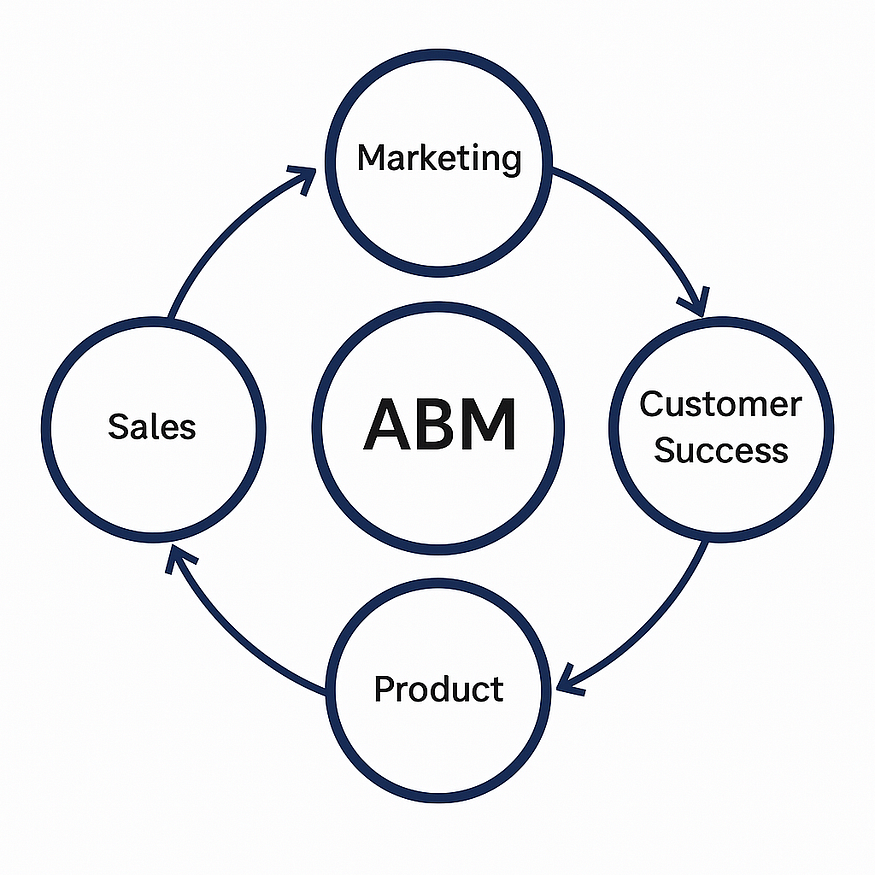
You can even structure dashboards around the four pillars.
ZenABM mirrors this on LinkedIn:
- See company-level engagement by campaign.

- Push engagement into CRM as company fields and auto-assign BDRs to hot accounts.
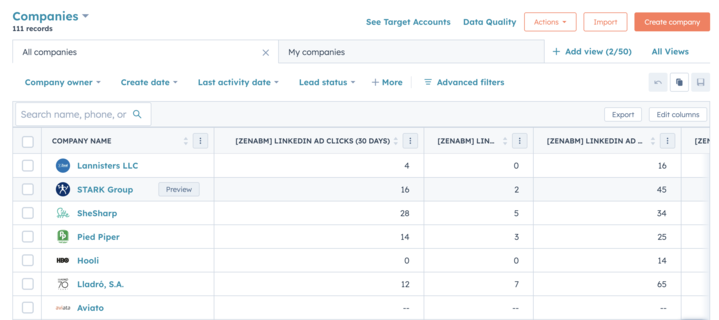
LinkedIn ad data pushed to company lists in the HubSpot CRM using ZenABM 
ZenABM assigns your BDRs to accounts in the “interested” stage - Use prebuilt revenue and engagement dashboards to quantify impact.

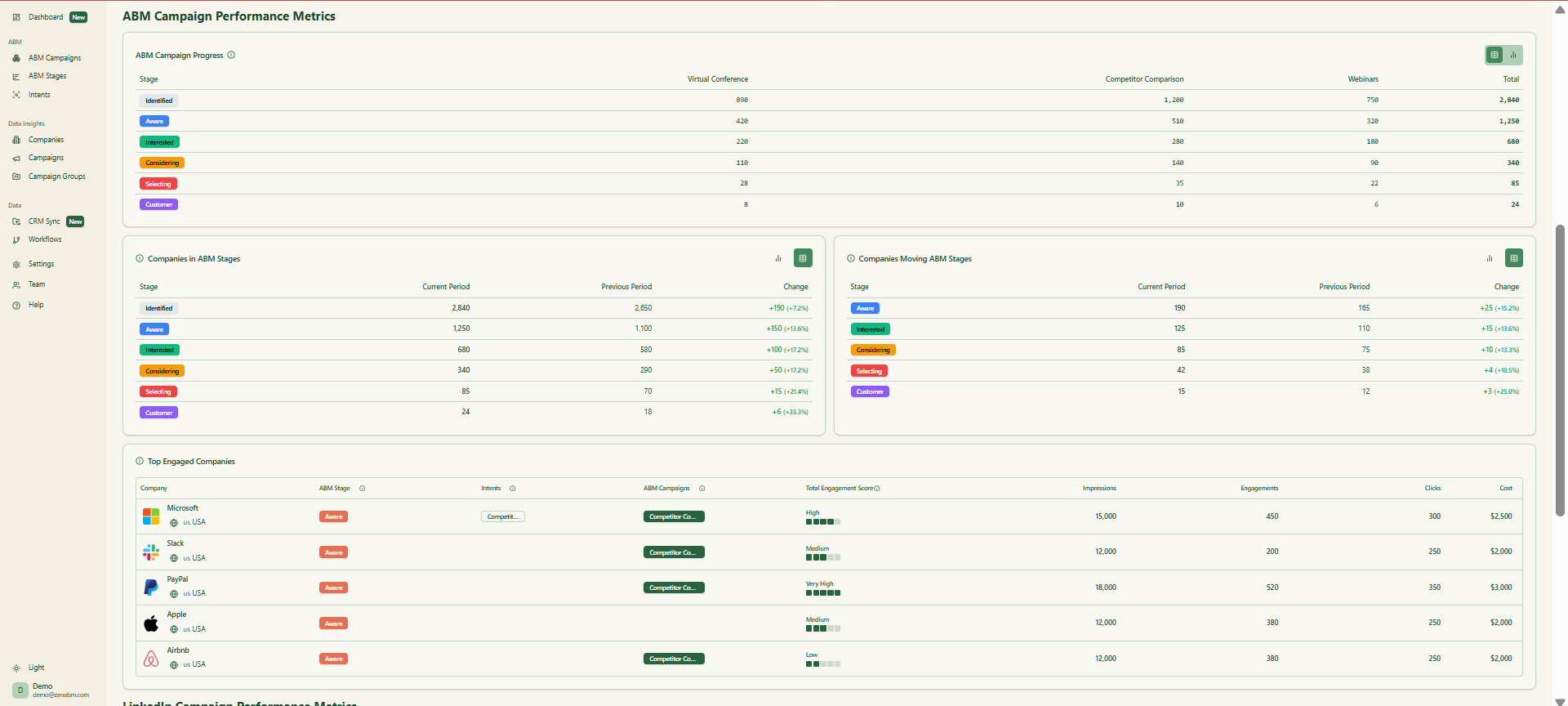
SPICED and MEDDPICC: Align ABM With Sales Qualification
SPICED and MEDDPICC are sales frameworks. Smart ABM teams borrow them.
SPICED
From Winning by Design: Situation, Pain, Impact, Critical Event, Decision.
Wouter Dieleman shows how to craft one-to-one account plans with SPICED in his post:
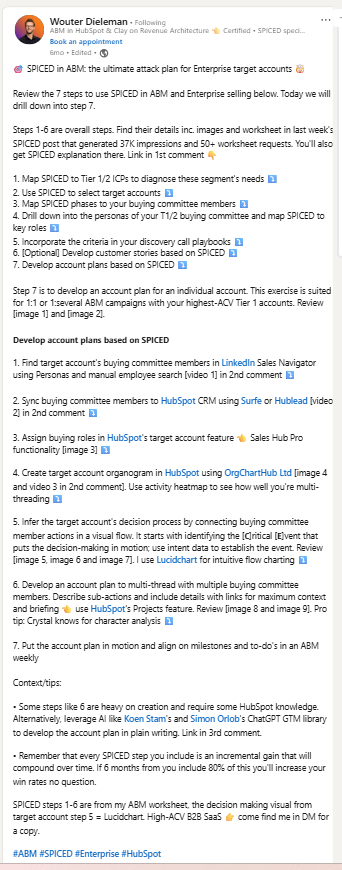

For each account (and key personas), outline:
- Situation
- Pain
- Impact
- Critical Event
- Decision path
Then align content and timing to those realities.
He also details a seven-step SPICED approach for one-to-one ABM:
- Map SPICED to Tier 1/2 ICPs.

- Select target accounts using SPICED.
- Map SPICED stages to buying roles.
- Drill into personas and align messages.
- Embed the criteria in discovery playbooks.
- [Optional] Build customer stories from SPICED.
- Develop account plans from the outputs.
MEDDPICC (or MEDDIC)
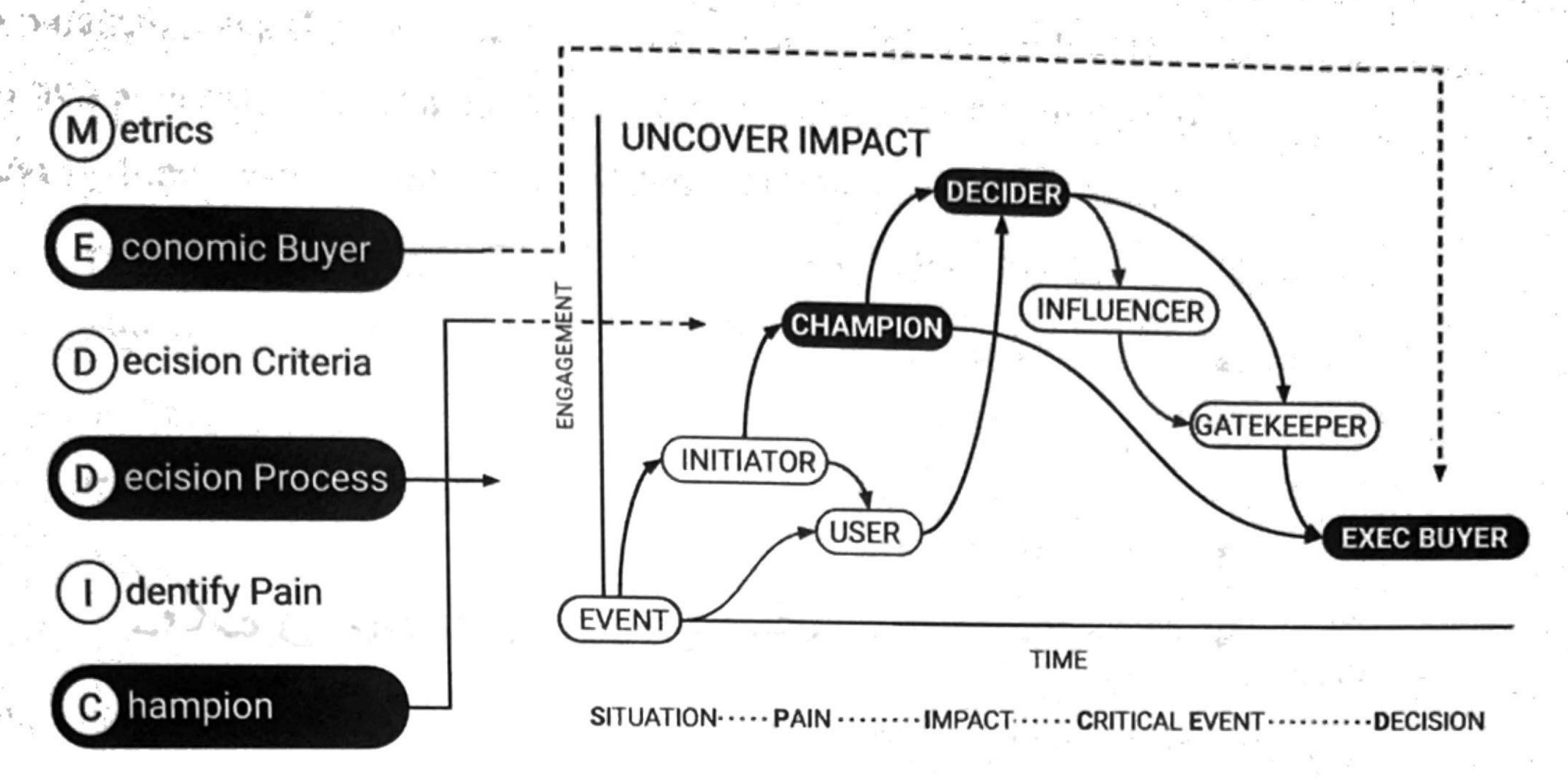
The elements:
- Metrics
- Economic Buyer
- Decision Criteria
- Decision Process
- Paper Process
- Identify Pain
- Champion
- Competition
Use it to ensure your ABM content covers what sales needs to close.
Jen Collins argues ABM + MEDDPICC is a strong alignment model:
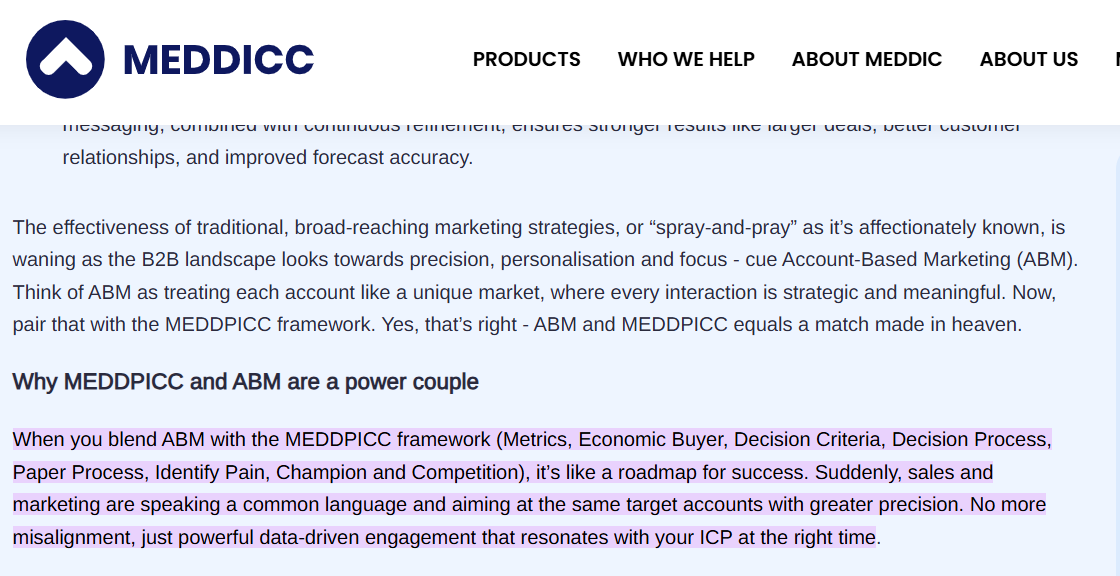
Examples:
- Metrics: Emphasize quantified outcomes in your case studies.
- Economic Buyer: Create C‑suite invites and executive assets.
- Decision Criteria: Address the specifics they will score.
- Champion: Equip internal champions with reusable decks.
- Competition: Publish comparisons that highlight your edge.
Other Frameworks: CHALLENGER and SPIN
- Challenger: Teach new insights about their business. ABM lets you tailor the teaching per account. That’s Challenger at full power.
- SPIN: Situation, Problem, Implication, Need‑Payoff. Use it to structure discovery and content angles.
One-to-One ABM Tool Stack
| Tech Stack Component | Purpose & Key Functions | Example Tools & Usage Tips |
|---|---|---|
| Account Data & Intelligence | Fuel selection and personalization with firmographics, org charts, contacts, and intent. | Tools: ZoomInfo, LinkedIn Sales Navigator, Clearbit; intent from Bombora, 6sense, Demandbase.
Use these to build lists and messaging. Intent reveals who’s researching topics like “zero‑trust.” Sales intel and LinkedIn alerts supply timely triggers. |
| ABM/Marketing Automation Platforms | Integrated suites for identification, ads, web personalization, and analytics across many accounts. | Demandbase, 6sense, Terminus, Triblio, RollWorks.
They deanonymize account visits, model buying stages, run account-targeted media, and centralize engagement. Powerful, but pricier. Pilot with lighter tools if you’re early, then scale. |
| CRM & Marketing Automation (MAP) | Core systems configured for account-centric work. Keep account objects clean and connected. | Salesforce, HubSpot for CRM; Marketo, HubSpot Marketing Hub, Pardot for MAP.
Enable lead-to-account matching, tier fields, and account views. Integrate your ABM platform so engagement auto-creates tasks for reps. This prevents signal loss. |
| Personalization & Sales Engagement | Operationalize human, multi-touch outreach at scale without losing authenticity. | Outreach, Salesloft for sequences; Drift for targeted chat; Sendoso, Alyce for direct mail.
AI can draft first-pass personalization; humans should refine. Don’t over-automate. Relationships still win one-to-one ABM. |
| Analytics & Reporting | Expose account engagement and business impact so you can optimize, not guess. | ABM platforms include dashboards. Attribution tools like Bizible help, though account-centric metrics often suffice.
ZenABM connects LinkedIn ad engagement to CRM opportunities to show which campaigns drive pipeline and revenue. Build account-level dashboards to track stage progression and heat. |
| Data Quality & Maintenance | Accurate, current data so personalization lands and ops run smoothly. | Assign ownership for hygiene in RevOps. Merge dupes, refresh titles, enrich firmographics, fix industries/tags. Poor data breaks one-to-one ABM. |
| Strategy & Alignment | Keep tech in service of strategy. Prove ROI, then expand. | Strategy first. Tools second. Pilot with CRM/MAP + LinkedIn + a light intent feed. Scale once the motion proves pipeline. |
ZenABM for One-to-One ABM Success
ZenABM is built for LinkedIn-first ABM analytics and orchestration.
It closes the gap between ad engagement and revenue outcomes.
Key capabilities:
- LinkedIn Engagement Insights: Pulls company-level impressions and clicks into your CRM so you can spot accounts showing intent and prioritize action.


LinkedIn ad data pushed to company lists in the HubSpot CRM using ZenABM - Account Scoring & Stage Views: Dashboards score accounts on engagement and segment by stage so you tailor the next touch.


- CRM Integration & Real-Time Alerts: Syncs to CRM so sellers see signals in-account and get alerted when heat rises.

- Pipeline Impact: Connects campaigns to opportunities so you can attribute pipeline and wins, not just clicks.


The Future of One-to-One ABM
ABM is finally getting the focus it deserves.
Enterprise teams are pushing into advanced approaches and smarter tooling.
Key shifts:
- AI and automation will accelerate one-to-one ABM workflows. ZenABM has an AI agent for LinkedIn ABM automation on the roadmap.
- ABM and broader revenue motions are converging into ABX. Expect account-focus across lifecycle, fewer silos between ABM and demand gen, and broader “strategic marketing” roles.
- Deeper ties with product and CS for retention and expansion. True “Account Teams” become standard.
- More creative physical or experiential plays to offset digital fatigue.
- ABM communities will grow fast. Expect more shared playbooks and benchmarks.
In short: the principles behind one-to-one ABM stay constant. Execution gets smarter, more connected, and more data-driven.
Over to You
Winning with one-to-one ABM takes sharp personalization, airtight alignment, and disciplined orchestration backed by the right data.
Use this playbook and platforms like ZenABM to outpace competitors and turn target accounts into customers.
Try ZenABM for free now or book a demo.

